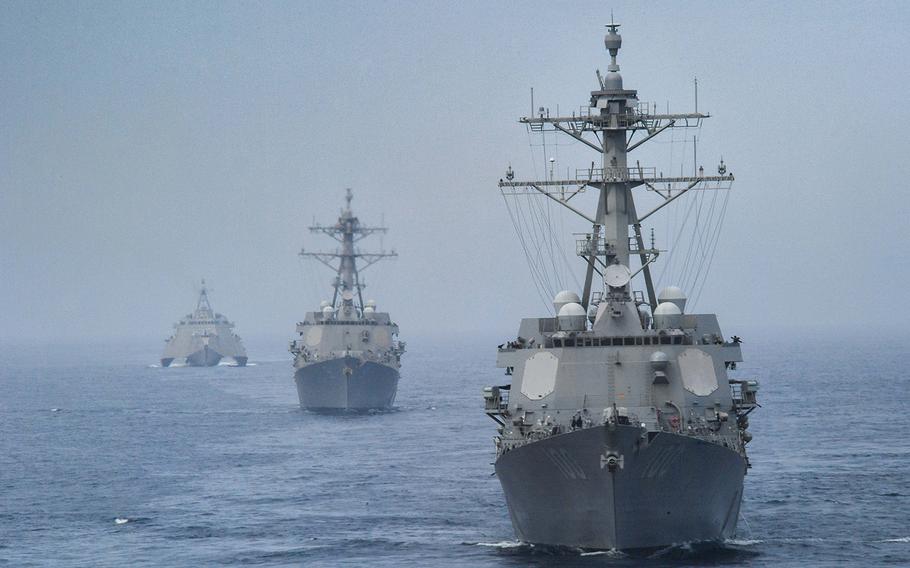
The Arleigh Burke-class guided-missile destroyers USS Kidd, foreground, and USS Pinckney sail ahead of the littoral combat ship USS Omaha in the eastern Pacific Ocean, July 25, 2019. (Olympia McCoy/U.S. Navy)
The Navy is asking Congress for more than $5 billion next fiscal year to build three more Arleigh Burke-class destroyers, according to a Congressional Research Service report published Tuesday.
Building the warships would bring the number of guided-missile destroyers the Navy has procured to 85, according to the report. The latest version, or Flight III, incorporates a new air and missile defense radar system that requires further changes to the destroyer design.
Two shipbuilders — General Dynamics’ Bath Iron Works in Maine and Huntington Ingalls Industries’ Ingalls Shipbuilding in Mississippi — are capable of the job if Congress approves the estimated $1.8 billion for each vessel.
Construction of Arleigh Burke-class destroyers started in 1985 and their design has been modified over time. The Navy stopped building Arleigh Burkes from 2007-09 while it procured three Zumwalt-class destroyers instead.
Originally planning to put 32 Zumwalts to sea, the Navy curtailed their production when the price per ship continued to rise, according to the Congressional Research Service.
Destroyers and cruisers are considered “large surface combatants,” as opposed to “small surface combatants,” which include frigates, littoral combat ships and other vessels. The Navy in 2016 set a goal of 355 ships, of which 104 would be large ships.
At the end of the 2018 fiscal year, the Navy had a force of 88 large combatant ships, including 66 destroyers, according to the updated report, “Navy DDG-51 and DDG-1000 Destroyer Programs: Background and Issues for Congress.” If it sticks to its 30-year plan, the Navy will have 104 large warships by fiscal year 2029.
However, the Navy expects to procure its last destroyers in fiscal year 2025, after which it plans on a new class of large warship, according to the report.
The guided-missile destroyers specialize in air defense and come equipped with the Aegis combat system, which uses computers and radar to track and destroy targets.
For defense against enemy air and missile attack, destroyers procured since fiscal year 2017 will come equipped with the next generation air and missile defense radar, the SPY-6.
The SPY-6, produced by Raytheon, requires “considerable changes to the ship’s hull, mechanical, and electrical systems,” according to a May report from the Government Accounting Office. The research service cited the GAO study in its report to Congress.
The SPY-6 must also work alongside Aegis, but a software glitch the Navy identified in 2018 delayed Navy tests of that ability by a year. Nonetheless, the GAO reported, the Navy plans to install the reworked SPY-6 system on new destroyers first and test its integration with Aegis at sea rather than on land.
The GAO report found that plan entails a risk of having to make costly retrofits if problems arise.
The Navy wants the destroyers funded under a multiyear procurement contract, which must also be approved by Congress. A multiyear contract has the potential to show savings of 5-15% over a single-year contract, according to the Congressional Research Service, “Multiyear Procurement and Block Buy Contracting in Defense Acqisition: Background and Issues for Congress,” updated Monday.